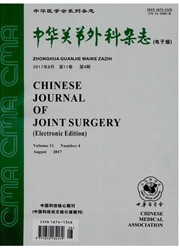

 中文摘要:
中文摘要:
假体关节感染是人工关节置换术灾难性的并发症;金黄色葡萄球菌是最主要的致病菌之一。生物膜在金葡菌假体关节感染的发生发展中扮演了重要角色,生物膜保护细菌免于机体免疫,抗生素和杀菌剂的攻击。生物膜的形成包括细菌的初始黏附,细菌聚集,生物膜成熟和细菌脱离生物膜回归游离态四个步骤。根据其主要成分,生物膜可分为多糖胞间粘附素依赖和非多糖胞间粘附素依赖两种;生物膜的其他成分还包括细胞外DNA和磷壁酸等。金黄色葡萄球菌的生物膜受激活或抑制生物膜组分的复杂信号分子网络调控的,包括agr基因控制的群体感应系统,受Sar A和sigma B调节的ica ADBC基因簇等。本文拟对金黄色葡萄球菌假体关节感染中生物膜形成和调节分子机制作简要综述。
 英文摘要:
英文摘要:
Prosthetic joint infection( PJI) is a disastrous complication of arthroplasty and staphylococcal aureus( S. aureus) is one of the leading causative pathogens. Biofilm plays a key role in the pathogenesis of S. aureus induced PJI. Biofilm is able to protect the bacteria in it from antibiotics,bactericidal agents and host immune attacks. The development of biofilm follows a four-step circle: primary attachment of the bacteria,bacterial aggregation,biofilm maturation and bacteria dispersing from biofilm to planktonic state. According to their main components,biofilms are divided into polysaccharide intercellular adhesin dependent and polysaccharide intercellular adhesin independent biofilms. Other components of biofilm include extracellular DNA and teichoic acid. S. aureus biofilm is regulated by a complicated network of signal molecules,which either promotes or inhibits the biofilm components,including quorum sensing system controlled by agr genes,ica ADBC locus regulated by Sar A and sigma B,etc.. This review intended to concisely depict the molecular mechanisms of biofilm development and regulation in S. aureus induced PJI.
 同期刊论文项目
同期刊论文项目
 同项目期刊论文
同项目期刊论文
 期刊信息
期刊信息
